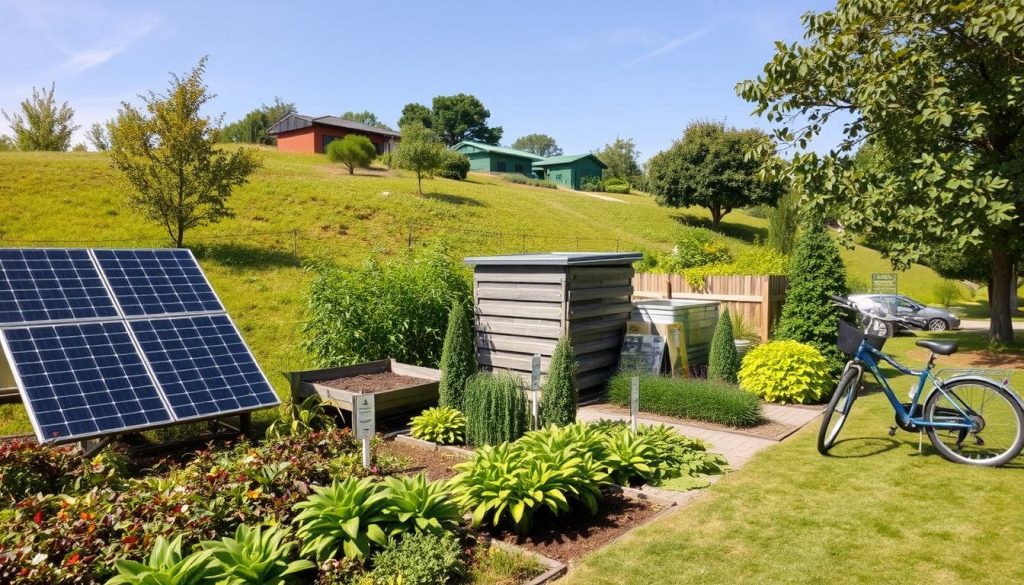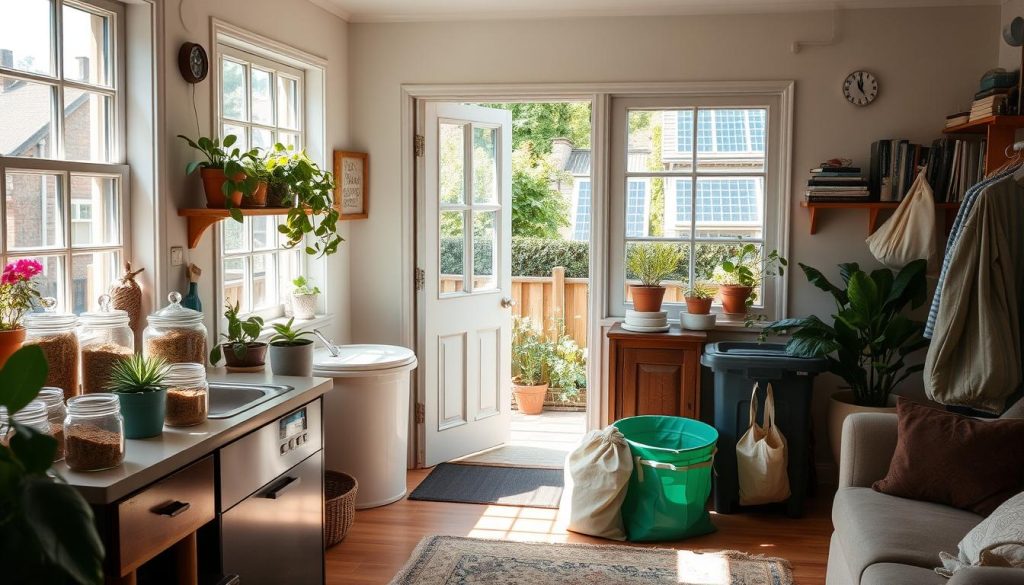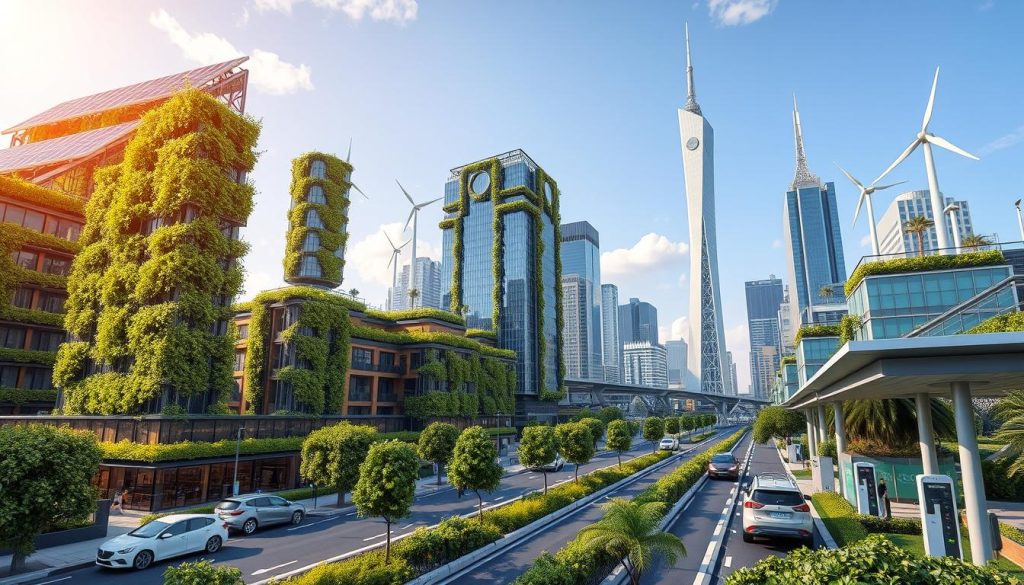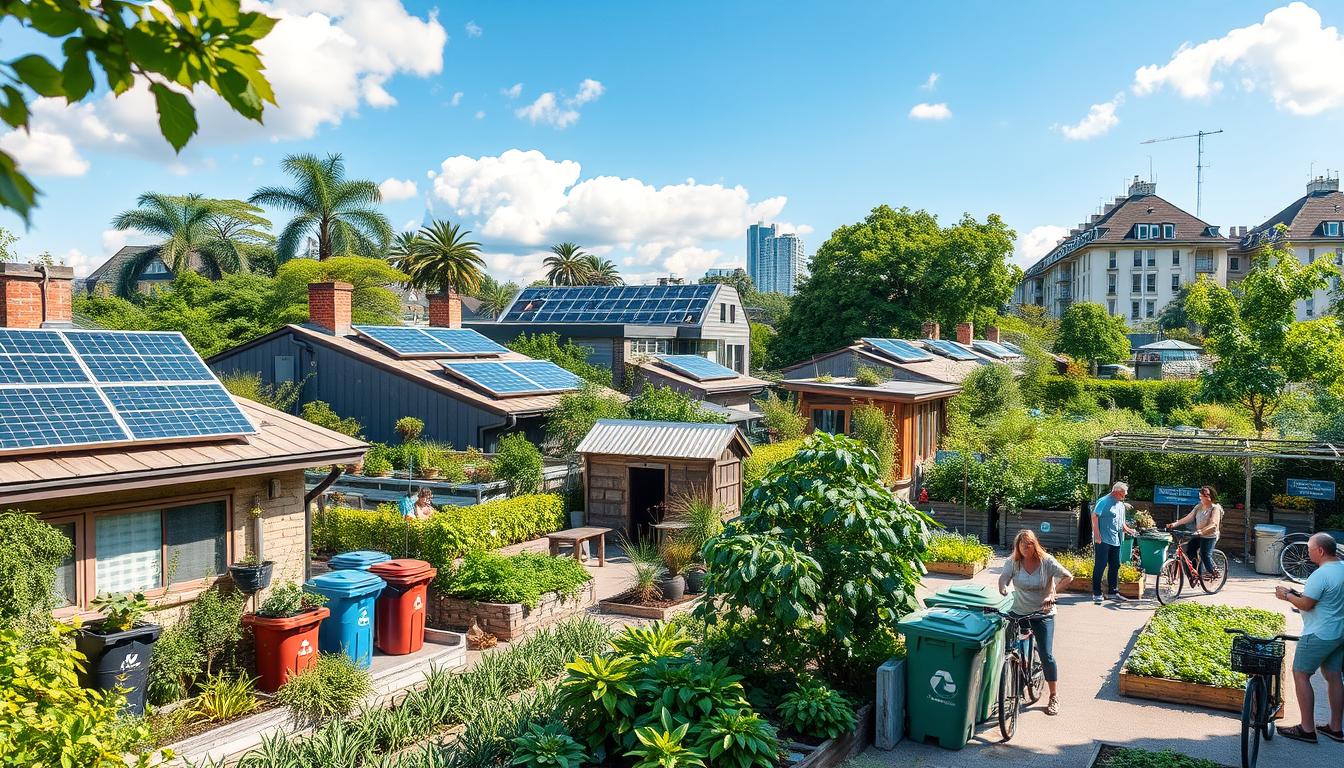In today’s fast world, mixing green living with digital sustainability is key. My path to zero waste has been helped a lot by technology. It makes managing and cutting down waste easier.
Smart home gadgets and digital tools have made living green simpler. They help tackle the problem of electronic waste too.
Using these tech advances, I aim to lessen my environmental footprint. This move is towards a greener future. Let’s see how tech and zero waste can change our lives for the better.
Understanding the Zero Waste Concept
The zero waste concept is a big change in how we use resources. It aims to make sure everything is reused, cutting down trash going to landfills and incinerators. It sees waste as a problem to fix, pushing for products made to be reused, which helps the environment.
What is Zero Waste?
Zero waste is more than actions; it’s a way of life. It’s about seeing everything as a resource, not waste. This means designing products for long use, fixing and recycling, and choosing materials that can be composted or fully recycled.
The Importance of a Zero Waste Lifestyle
Living a zero waste life has many benefits. It’s good for the environment, saving resources and reducing pollution and climate change. It also saves money by using less material and cutting waste costs. Plus, it brings people together for a common goal of protecting the environment.
How Technology Supports Zero Waste Efforts

Technology can help us live more sustainably. By using the right gadgets and apps, we can cut down on waste easily. This makes achieving zero waste goals simpler and more precise.
Smart Home Devices for Reduced Waste
Smart home devices are key in reducing waste. They include energy-saving thermostats, smart lights, and automated recycling units. These tools help lower your home’s environmental impact.
For example, the Nest Learning Thermostat adjusts your heating and cooling based on your habits. Philips Hue smart lights can also save energy by following your schedule.
Apps to Track and Manage Waste
Many apps help users track and manage waste. They offer tips and strategies to reduce waste. Apps like MyWaste and iRecycle help you monitor your waste and suggest ways to recycle.
They also have features like barcode scanning for disposal instructions and finding recycling centers near you. This makes managing waste easy and convenient.
My Journey Towards a Zero Waste Lifestyle

Starting my personal zero waste journey changed me. It made me adopt eco-friendly living into my daily life. This needed patience, trying new things, and changing old habits.
Starting Small: First Steps I’ve Taken
I began with small but big changes. I used reusable containers and bags instead of plastic ones. It was empowering to switch to sustainable options.
I looked at my daily habits to find ways to reduce waste. For example, using a reusable water bottle and coffee cup reduced my disposable items a lot.
- Implemented reusable shopping bags and containers
- Switched to a reusable water bottle and coffee cup
- Experimented with DIY household cleaners
Challenges I Faced and Overcame
The personal zero waste journey had its tough moments. Finding alternatives for everyday items was hard. I had to change how I shopped for things like soap and grains.
Also, making these new habits part of my daily life was tough at first.
| Challenge | Solution |
|---|---|
| Finding zero waste alternatives | Explored local farmers markets and specialty stores |
| Integrating new habits | Used technology apps to track progress and set reminders |
Technology helped me a lot during this time. Apps helped me keep track of my purchases and waste. This kept me motivated and focused on eco-friendly living.
Practical Technology Solutions for Waste Reduction

Using modern technology can help us reduce waste. It helps us use efficient strategies and green tech to live more sustainably.
Digital Tools for Meal Planning
Digital tools for meal planning can cut down on food waste. Apps like Yummly and Mealime help plan meals and shop for groceries. They guide us to eat healthier and use ingredients better.
These tools make it easier to avoid buying too much and reduce food waste. By planning meals, I know what to buy and avoid impulse buys.
Utilizing E-Books and Digital Resources
Switching to e-books and digital resources also helps reduce waste. It cuts down on deforestation and paper production’s environmental impact.
Platforms like Amazon Kindle and Apple Books offer a wide range of e-books. They make reading convenient and help reduce waste. I’ve seen less clutter and easier access to more materials.
Let’s compare digital solutions to traditional methods:
| Traditional Method | Digital Solution | Waste Reduction Impact |
|---|---|---|
| Physical Meal Planner | Meal Planning App | Reduced paper waste |
| Printed Books | E-Books | Reduced deforestation, lower carbon footprint |
| Paper-based Subscriptions | Online Subscriptions | Less physical waste |
Using digital tools helps me live more sustainably. These green tech innovations are key to reducing waste and creating a greener future.
Community and Collaboration in Zero Waste
Building a zero waste lifestyle is more than just personal effort. It thrives on community and collaboration. Local support networks and online zero waste communities are key to this journey. They make our zero waste experiences richer and help create a sustainable future.
Finding Local Support Networks
My first step towards zero waste was joining local support networks. These groups gave me valuable resources and insights. They share practical tips for reducing waste, creating unity and purpose.
Workshops and meetups offer a personal learning experience. You can interact face-to-face and learn from others.
Joining Online Zero Waste Communities
Online zero waste communities add another layer of support. They are accessible from anywhere. Social media groups and forums are full of advice, encouragement, and success stories.
By joining these forums, I found a global network of zero waste enthusiasts. These online interactions show we’re all part of a bigger movement. We’re working together towards a sustainable future.
Here’s a comparison of local support networks and online zero waste communities:
| Aspect | Local Support Networks | Online Zero Waste Communities |
|---|---|---|
| Accessibility | Regional | Global |
| Interaction | Face-to-face | Virtual |
| Resource Sharing | Localized Resources | Diverse, Broad Resources |
| Support Type | Personal, Immediate | Remote, Flexible |
Combining local support networks and online communities offers a balanced approach. It creates a comprehensive support system. This enhances your efforts towards a zero waste lifestyle.
The Future of Technology in Waste Management
Looking ahead, new tech in waste management will change how we deal with trash. New tech trends and green startups are key to a cleaner Earth.
Innovative Tech Trends to Watch For
Artificial intelligence (AI) and machine learning are big in waste management now. They help sort recyclables better, making recycling cleaner. Blockchain also helps track waste, making recycling more open and honest.
IoT devices, like smart bins, are changing waste handling. They tell collectors when bins are full, saving time and money. This also cuts down on pollution from waste transport.
Sustainable Startups Leading the Way
Green startups worldwide are leading in waste solutions. TerraCycle and The Ocean Cleanup are great examples. TerraCycle works on recycling hard materials, and The Ocean Cleanup cleans oceans of plastic.
Startups like BioCellection and Recycleye are also making a difference. BioCellection breaks down plastics into useful chemicals. Recycleye uses AI robots to sort waste fast and well.
Here’s a look at some of these green startups:
| Startup | Focus Area | Key Innovation |
|---|---|---|
| TerraCycle | Hard-to-Recycle Materials | Programs for converting waste into reusable contexts |
| The Ocean Cleanup | Ocean Plastic Pollution | Advanced cleanup systems for water bodies |
| BioCellection | Plastic Waste | Chemical breakdown of plastics |
| Recycleye | Waste Sorting | AI-driven robotic sorting systems |
Tips for Integrating Technology into Daily Life
Adding technology to our daily lives helps make our homes more sustainable. Smart devices and eco-friendly innovations cut down waste and track our environmental impact. Here, I’ll share tips for a green home and resources for learning more.
Creating a Sustainable Home Environment
Start by using smart home tech to reduce waste and save energy. For example, smart thermostats like the Nest Learning Thermostat adjust your home’s temperature better. This cuts down on energy use.
Smart lighting, like Philips Hue, also helps. It changes light levels based on the sun, saving electricity. Using energy-efficient appliances and smart plugs can also save energy and money. These steps help make your home more eco-friendly.
Resources for Continuous Learning and Improvement
Keeping up with sustainability trends and improving your zero waste habits requires learning. There are many resources to help you. Blogs like “The Zero Waste Home” and podcasts like “Sustainababble” share tips and stories.
Online courses on platforms like Coursera and edX teach about environmental science and sustainable living. They help you learn more and improve your green efforts. These tools keep you informed and help you grow in your sustainability journey.
By using technology wisely and learning from these resources, we can all live more sustainably. This helps our planet and makes a positive impact.

